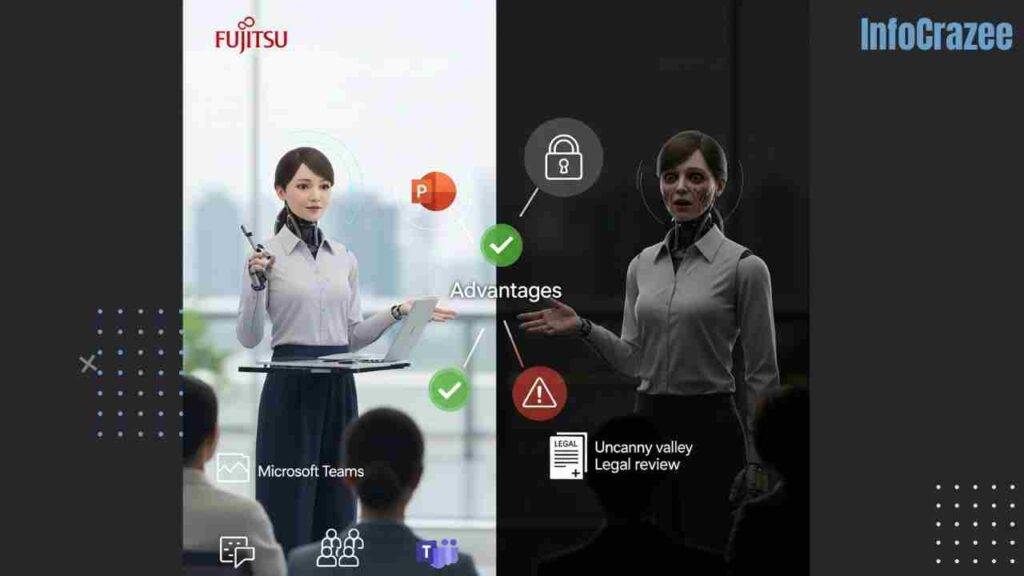Could Fujitsu’s AI Avatars Redefine the Future of Work Presentations?
Ever dreaded putting together a presentation, only to realize you’d have to deliver it in a language you barely speak? Or maybe you’re just tired of fumbling through PowerPoint slides in front of a crowd? Fujitsu’s new AI Auto Presentation technology, launched on June 19, might just be your new best friend. This tool lets AI avatars—digital versions of you—create and deliver polished presentations in over 30 languages, all while answering audience questions like a pro.We’re diving into whether these AI avatars are really the future of workplace presentations. Spoiler: they’re pretty impressive, but let’s break it down!
What’s Fujitsu’s AI Auto Presentation?
Imagine uploading a PowerPoint deck, sitting back, and letting an AI version of yourself handle the whole presentation. That’s the gist of Fujitsu’s AI Auto Presentation, a feature of their Fujitsu Kozuchi AI service. It uses Microsoft 365 Copilot to turn your slides into a full-on talk, complete with a personalized AI avatar that looks and sounds like you. The tech, developed with Headwaters Co., Ltd., is set to roll out for corporate trials starting June 19, 2025, with internal use at Fujitsu in Q2 and global customer access in Q3.
- How it works: The AI pulls data from your slides, crafts a script, and delivers it in your voice. It even switches slides automatically based on time limits and answers questions using pre-loaded company info.
- Cool perk: It supports over 30 languages, so you can present to a global team without worrying about your accent or vocab.
- Fun fact: The slide-timing feature is so slick, Fujitsu’s applied for an international patent
Why This Could Change Workplace Presentations
I’ve been in meetings where the presenter was sweating bullets, struggling to explain slides in a second language or dodging tricky questions. Fujitsu’s AI avatars aim to fix that, making presentations smoother and more inclusive.
Saves Time and Stress
- Real-world win: No more late nights tweaking slides or rehearsing. The AI handles scripting and delivery, freeing you up for other tasks. Fujitsu says it cuts prep time significantly, boosting efficiency.
- Example: Imagine you’re a manager with a global team. Instead of stressing over a presentation in Mandarin, your AI avatar nails it while you focus on strategy.
Breaks Language Barriers
- Real-world win: With 30+ languages, the AI makes your pitch accessible to diverse audiences. It’s like having a translator who also knows your slides inside out.
- Example: A sales rep in Japan can pitch to clients in Brazil without worrying about Portuguese fluency, thanks to the AI’s natural, context-aware translations.
Levels the Playing Field
- Real-world win: Not a confident speaker? No problem. The AI delivers pro-level presentations, so everyone—from interns to CEOs—can share ideas confidently.
- Example: I once worked with a shy colleague who had brilliant ideas but froze during presentations. An AI avatar could’ve let her shine without the spotlight.
Answers Questions on the Fly
- Real-world win: Using retrieval-augmented generation (RAG), the AI pulls from pre-loaded company data to answer audience questions accurately, even if you’re not an expert.
- Example: Picture a training session where the AI fields technical questions, saving you from awkward “I’ll get back to you” moments.

Could This Really Be the Future?
Fujitsu’s vision is bold: a world where anyone can deliver top-notch presentations, no matter their skills or language. Microsoft Japan’s Satoshi Asano agrees, saying it’ll “streamline marketing operations” and speed up knowledge sharing. But is it truly the future? Let’s weigh the pros and cons.
Why It Might Be
- Seamless integration: Works with Microsoft Teams and PowerPoint, tools most offices already use, so it’s easy to adopt.
- Global reach: Perfect for companies with international teams, as it eliminates language and time zone hurdles.
- Customization: You can tweak the avatar’s tone, style, and content slide-by-slide, making it feel personal and on-brand.
What Could Hold It Back
- Uncanny valley vibes: Some might find AI avatars creepy or impersonal, especially if they’re not quite lifelike. Zoom’s CEO faced this with his AI double, which felt “slightly uncanny.”
- Privacy worries: Using your voice and likeness raises data security questions. Fujitsu needs airtight safeguards to prevent misuse, like deepfake scams seen at WPP.
- Overreliance on AI: If teams lean too heavily on avatars, it might dull real presentation skills or make meetings feel robotic.
- Legal hurdles: Laws on AI-generated content vary globally, so companies will need to navigate compliance carefully.

How to Make the Most of AI Avatars
Thinking about trying Fujitsu’s tech? Here’s how to use it smartly, based on what we know from Fujitsu’s rollout plan and industry trends:
- Test it out: Sign up for the corporate trial on Fujitsu’s Research Portal starting June 19, 2025, to see how it fits your team’s needs.
- Keep it human: Use the avatar as a tool, not a replacement. Add personal touches, like a quick live intro, to keep audiences engaged.
- Check the data: Make sure pre-loaded materials for Q&A are accurate to avoid AI “hallucinations” spreading wrong info.
- Train your team: Teach staff how to customize prompts for the best results, ensuring presentations match your brand’s style.
A Personal Take
I’ll admit, I’m both excited and a bit weirded out by this. I once spent hours prepping a presentation for a big meeting, only to choke on a question I wasn’t ready for. An AI avatar could’ve saved me, but I also love the thrill of connecting with an audience in person. Fujitsu’s tech feels like a superpower for busy or nervous folks, but I hope it doesn’t replace the human spark that makes great presentations memorable. What do you think—would you let an AI avatar take the stage for you?
What’s Next for Fujitsu’s AI Avatars?
Fujitsu’s betting big on this tech, with plans to integrate it deeper into Microsoft 365 and expand features. They’re not alone—CEOs at Zoom and Klarna are already sending AI doubles to meetings, hinting at a broader trend. As Fujitsu rolls out trials and gathers feedback, we’ll see if AI avatars become a workplace staple or just a flashy experiment. For now, they’re a promising tool for making presentations easier, more inclusive, and global-ready.






